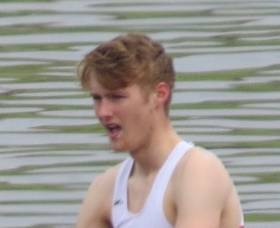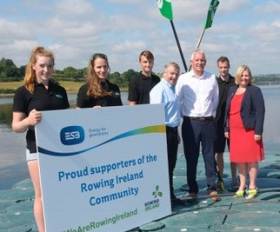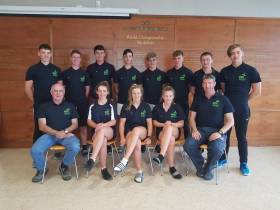Displaying items by tag: Coupe de la Jeunesse
Ireland Rowers Contend in A Finals at Coupe de la Jeunesse
#Rowing: Ireland had two boats which finished just outside the medal placings on the final day of the Coupe de la Jeunesse in Corgeno, Italy, today. The junior women’s and junior men’s quadruples both finished fourth. The women's crew of Sadhbh Scully, Aoife Lynch, Anna Tyther and Lucy McCoy were 1.34 behind the Czech Republic in a race won by Italy, with Spain second. As they had been on the Saturday, the men’s quadruple of Rory O’Neill, Thomas Kelly, Fionn O’Reilly and Andrew Sheehan were again held out of the final medal position by Britain.
Coupe de la Jeunesse, Corgeno, Italy, Day Two, Sunday (Irish interest)
Men
Junior Quadruple – A Final: 4 Ireland 6:17.33
Women
Junior Four – B Final: 1 Ireland 7:24.53
Junior Pair – B Final: 1 Ireland 8:05.15
Junior Quadruple – A Final: 4 Ireland 7:01.60
Junior Double – B Final: 6 Ireland 7:55.41.
#Rowing: The Ireland junior men’s quadruple finished just outside the medals at the Coupe de la Jeunesse in Corgeno, Italy, today. The crew of Rory O’Neill, Thomas Kelly, Fionn O’Reilly and Andrew Sheehan were just .87 off a medal. Italy won from Spain, with Britain just ahead of Ireland in bronze medal spot.
Ireland had two other A Finalists: the junior double of Chris Kirwan and Holly Davis finished fifth. The new unit had finished a good second in their heat, and were in the leading three in their race until the final quarter. The junior women’s pair of Claragh O’Sullivan and Jane Duggan also took fifth.
The junior women’s quad and four took second in their B Finals.
Sunday gives all the crews another chance to compete in heats and finals.
Coupe de la Jeunesse, Corgeno, Italy (Irish interest)
Men
Junior Quadruple – A Final: 4 Ireland 6:21.12.
Women
Junior Four – B Final: 2 Ireland 7:39.41.
Junior Pair – A Final: 5 Ireland 8:26.52.
Junior Quadruple – B Final: 2 Ireland 7:23.26.
Junior Double – A Final: 5 Ireland 8:09.44
Ireland Eight Open Coupe Campaign
#Rowing: Ireland’s junior women’s eight finished seventh in the first race of the Coupe de la Jeunesse in Corgeno, Italy. The race was won by Spain, with the Netherlands second and Britain third. Eight crews competed.
The Coupe has two full days of action on Saturday and Sunday.
#Rowing: Ireland took a bronze medal in the junior men’s pair at the Coupe de la Jeunesse at the National Rowing Centre today. The crew of Odhran Donaghy and Nathan Timoney finished behind Belgium and Italy. On Saturday, Ireland had taken a bronze medal in the men’s coxed four final and took a silver medal in the women’s double (Molly Curry and Aoibhinn Keating) and a bronze in the men’s pair (Donaghy and Timoney) on the basis of heat times as finals could not be held because of the high winds. Britain won the overall prize and topped the junior men's rankings. They were second to France in the junior women's table. Ireland were third overall in the men's and women's rankings .
ESB Backs Rowing Festival at Inniscarra
#Rowing: ESB has teamed up with Rowing Ireland to support a series of prestigious rowing regattas on Inniscarra Reservoir this month. The Coupe de la Jeunesse, from July 27th to 29th, will attract talented young rowers from 13 countries across Europe. Up to 750 rowers and their support teams are expected in the Cork area for this high-profile event. The event is open to rowers who are 18 years or under. The Festival of Rowing programme also includes the Irish Rowing Championships taking place this weekend, July 13th to 15th, as well as the Home International Regatta which takes place on July 21st.
Rowing Ireland CEO Michelle Carpenter said: “We are delighted with the ESB support of our exciting Festival of Rowing which commences this weekend with the biggest ever Irish Rowing Championships. The relationship between the ESB and Rowing Ireland has been pivotal and we are delighted to have them support our celebration of Irish and International here at our High Performance home in Inniscarra.”
Frank Barry, Plant Manager at ESB’s Lee Stations said: “In what is a milestone month for the rowing community, ESB is delighted to support Rowing Ireland in their hosting of these three upcoming regattas on Inniscarra Reservoir. This support builds on our long-standing relationship with the rowing community. In 2011, ESB entered a 25 year lease with Rowing Ireland which has facilitated development of world-class infrastructure at the National Rowing Centre. As such, the facilities at Farran provide a fitting backdrop as we welcome the international athletes for the 2018 Coupe de la Jeunesse in particular. On behalf of ESB, I wish all participants the very best of luck in these prestigious events.”
Cork County Council and Fáilte Ireland are also providing support for the events.
Cork Welcomes Coupe de la Jeunesse 2018
#Rowing: The Coupe de la Jeunesse will be hosted by Ireland this year. Young rowers from Austria, Belgium, Czech Republic, Denmark, France, Great Britain, Hungary, Italy, the Netherlands, Poland, Portugal, Spain, Switzerland and all across Ireland will compete at the National Rowing Centre from July 27th to 29th.
The Coupe de la Jeunesse is an annual international junior rowing regatta. The event, which was founded in 1985, is open to rowers 18 years or under. Points are awarded to nations based on finishing position in each category. As a result, a strong overall team is required to take overall victory at the Coupe. The event has only ever been won by Britain (14 wins), Italy (11 wins), and France (8 wins). Each category is raced separately on the first and second day of the regatta, allowing for different Coupe de la Jeunesse event winners on each day.
Ireland performed exceptionally well last year, highlighting our young talent in this growing Irish sport, bringing home a total of five gold medals across the women’s pair and men’s quadruple categories.
Rowing Ireland has been a proud member of the Coupe rowing family for many years and hosted this event in 1999 and 2008. The regatta, which encourages young rowers, has become a platform in Ireland for starting the international careers of some of our most successful and decorated Irish rowers such as Gary O’Donovan and Shane O’Driscoll.
Cork County Council is supporting the event. During his welcoming address, County Mayor Declan Hurley has urged those taking part in the Coupe de la Jeunesse to take the opportunity to explore Cork during their downtime.
“I would like to welcome all the visiting athletes, their coaches, families and supporters to our great county and commend these young rowers for the hard work, passion and dedication that has brought them here. While this is a competition, I wish to remind all participants to take some time to enjoy all that this county has to offer. Cork is truly a remarkable place with so much to do, see and experience. Go and kiss the Blarney Stone; take a trip on the Dursey Island Cable Car, running 250m above the sea; visit Mizen Head, the most south-westerly point in Ireland or sample some mouth-watering Cork artisan produce. There is so much to do in our beautiful county, I hope you enjoy each and every minute.”
Michelle Carpenter, the new chief executive of Rowing Ireland, said: “We are so excited to welcome young rowers from 13 countries across Europe to our fantastic home here at the National Rowing Centre in Farran Wood this July. To have the pleasure of announcing Ireland as host of this prestigious race as one of my first roles in my new position as CEO is such an honour. This is an event which I hold dear to my heart as I have been heavily involved in the Coupe for the last four years and have witnessed first-hand what a great opportunity this is for up and coming young rowers to grow.
“Rowing is such a historic sport, but beyond that, its reliance on teamwork and seamless synchronization forms bounds of friendship and family that really stand the test of time. If you can battle the waters together, you can achieve anything! I cannot wait for Cork to open its arms once again to the visiting Coupe family. While rowing is where the excitement lies, competitors and their families are always blown away by Cork’s friendliness, culture and scenic nature. I have no doubt our great county will pull out all stops, as always, to support our competitors, both home and foreign, this July.”
Young Irish athletes are competing to secure a place on the 2018 Coupe de la Jeunesse team. A crucial trial is taking place on Friday 18th May, after which the selection panel will review these young rowers’ performances, and also take into account their previous rowing history.
The National Rowing Centre in Farran Wood acts as the base for the Ireland high performance team. The course facilities have been upgraded in recent years and now consist of an Albano course with adjustable start, split timing and photo finish system.
Big Year for Three Rowing Codes
#Rowing: The year 2018 is set to be big one for Rowing Ireland. The National Rowing Centre will host a festival of rowing over three weeks in July. The Irish Championships, with an anticipated entry of over 1,100 crews, is first up. This is followed a week later by the Home International Regatta between Ireland, England, Scotland and Wales. The highlight of the festival will be the Coupe de la Jeunesse, which is a European junior tournament, with crews from 14 countries set to compete. All of this activity is taking place in Olympic or river style boats.
Now there are two other rowing codes under the Rowing Ireland umbrella.
In 2017 Rowing Ireland formed an Offshore Division. Offshore rowing or “FISA Coastal” rowing takes place in single, double and quad scull boats which are wider than Olympic boats and are self-bailing. The crews race a course with multiple turns around a single buoy where navigation is as important as pulling hard. The inaugural Irish Offshore Rowing Championships were held in Arklow in 2017. Over 20 crews competed in the FISA World Championships in France and they returned with a silver medal, taken by Monika Dukarska.
Rowing Ireland also created a Coastal Division in 2017. Coastal rowing has a tradition going back centuries and was often associated with boats rowing out to arriving ships to obtain work. Competition in traditional wooden boats or coastal fours takes place in lanes, with crews rounding individual buoys before returning to the start/finish line. The inaugural Irish Coastal Rowing Championships under the aegis of Rowing Ireland will take place in the National Rowing Centre in August on a separate part of the lake to the Olympic course.
Rowing Ireland brought boats from all three codes together for the first time at the National Rowing Centre on Saturday, February 24th for the picture above.
Five Gold Medals for Ireland Rowers as Fermoy Pair Win Again
#Rowing: Ireland took its fifth gold medal of the Coupe de la Jeunesse in Hazewinkel in Belgium today. Gill McGirr and Eliza O’Reilly were emphatic winners of the junior women’s pair. They led in silver-medal winners Italy by over six seconds. Britain took the bronze.
The two Fermoy women had also won gold on Saturday.
Earlier, the junior men’s quadruple had taken their second gold. Georgia O’Brien and the men’s four finished fourth and fifth respectively in their A Finals.
Coupe de la Jeunesse, Hazewinkel, Belgium – Day Two (Irish interest)
Junior Men
Four – Heat One: 2 Ireland (A Johnston, R Corrigan, B Connolly, N Timoney) 6:29.73. A Final: 5 Ireland 6:22.36.
Quadruple – Heat One: 1 Ireland (B O’Flynn, M Dundon, J Keating, J Quinlan) 6:20.92. A Final: 1 Ireland 6:10.07.
Junior Women
Pair – A Final: 1 Ireland (G McGirr, E O’Reilly) 7:37.86
Single – Heat: 1 Ireland (G O’Brien) 6:21.42. A Final: 4 Ireland 8:16.84
Coupe Fifth Place for Ireland Rowing Four
#Rowing: The Ireland junior men’s four finished fifth at the Coupe de la Jeunesse in Hazewinkel in Belgium. Britain showed impressive speed and won the A Final well, with Belgium taking silver and Portugal a surprise bronze. The Czech Republic and the Ireland crew of Aaron Johnston, Ross Corrigan, Barry Connolly and Nathan Timoney, were just behind this group.
Coupe de la Jeunesse, Hazewinkel, Belgium – Day Two (Irish interest)
Junior Men
Four – Heat One: 2 Ireland (A Johnston, R Corrigan, B Connolly, N Timoney) 6:29.73. A Final: 5 Ireland 6:22.36.
Quadruple – Heat One: 1 Ireland (B O’Flynn, M Dundon, J Keating, J Quinlan) 6:20.92.
Junior Women
Single – Heat: 1 Ireland (G O’Brien) 6:21.42.
Ireland's Crews All In A Finals Again at Coupe Rowing
#Rowing: Ireland’s four boats will again appear in A Finals today at the Coupe de la Jeunesse in Hazewinkel, Belgium. Two Ireland crews won their heats this morning and one finished second. The women’s pair of Gill McGirr and Eliza O’Reilly have a straight final.
Georgia O’Brien claimed victory in her heat by just over a second from Austria’s Alexandra Breschan, with Hungary taking the third qualification place, much further back.
The Ireland Quadruple also won. Poland and the Czech Republic took the second and third qualification spots behind the Ireland crew of Barry O’Flynn, Matt Dundon, Jack Keating and James Quinlan. In a tight finish, France took fourth and missed out by less than a second.
The Ireland four of Aaron Johnston, Ross Corrigan, Barry Connolly and Nathan Timoney finished second in their heat, just ahead of Belgium. Britain took first.
Coupe de la Jeunesse, Hazewinkel, Belgium – Day Two (Irish interest)
Junior Men
Four – Heat One: 2 Ireland (A Johnston, R Corrigan, B Connolly, N Timoney) 6:29.73
Quadruple – Heat One: 1 Ireland (B O’Flynn, M Dundon, J Keating, J Quinlan) 6:20.92.
Junior Women
Single – Heat: 1 Ireland (G O’Brien) 6:21.42.


































































